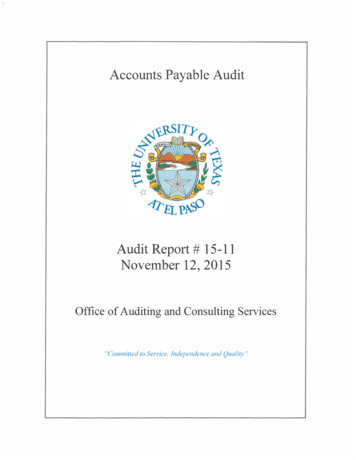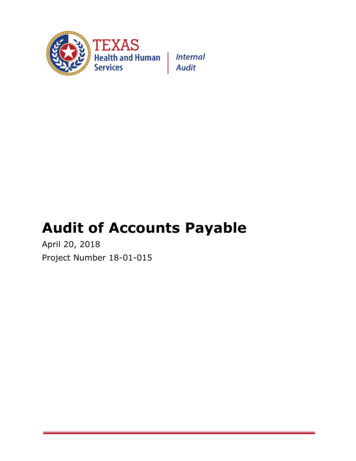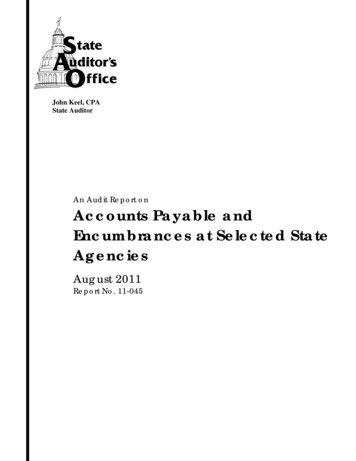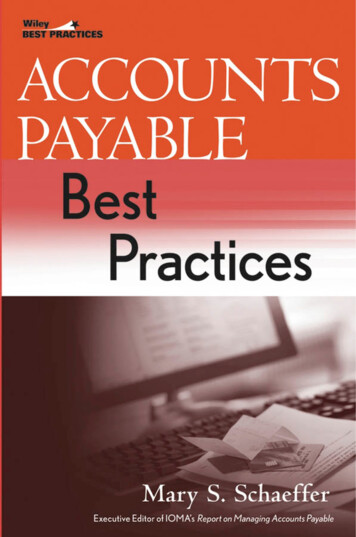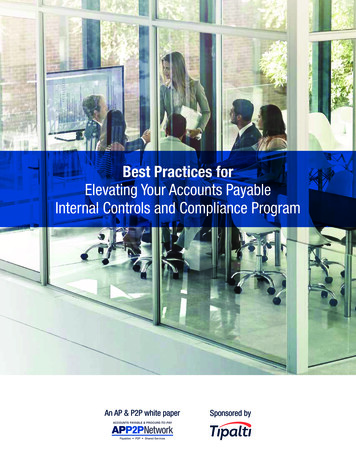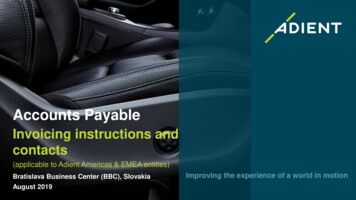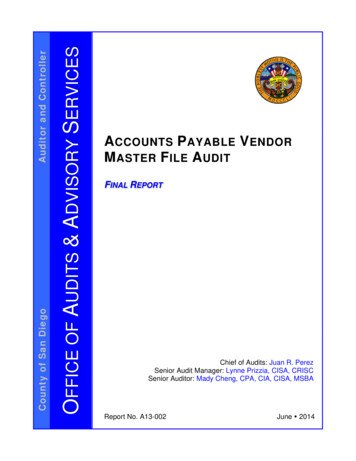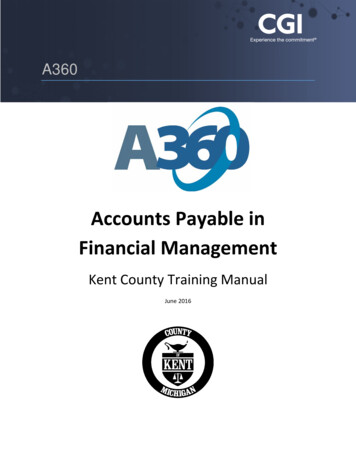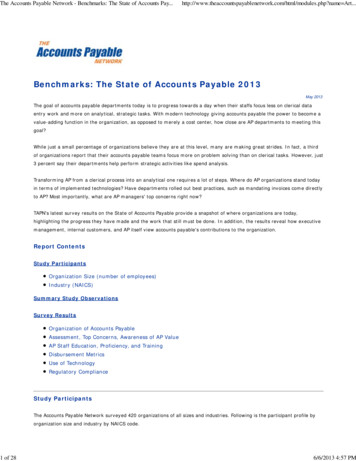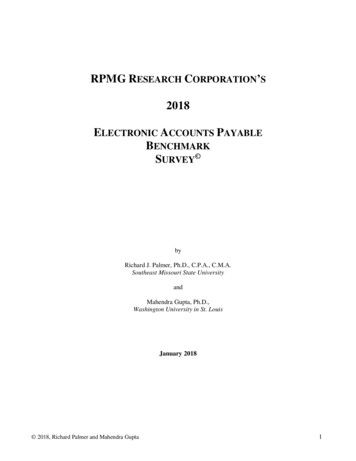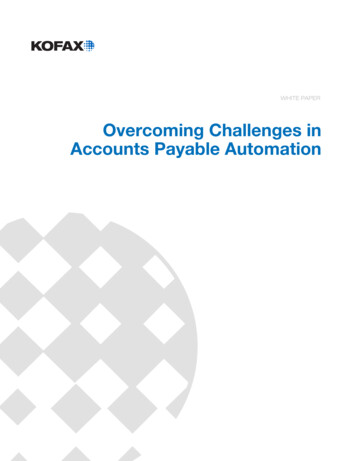
Transcription
WHITE PAPEROvercoming Challenges inAccounts Payable Automation
Overcoming Challenges in Accounts Payable AutomationOvercoming challenges in accounts payable automationExecutive summaryIAccounts payable automation presents unique challenges. It is characterized by large volumes of data,arriving in different formats and media that must be securely received, accurately interpreted and enteredinto financial systems. Transactions within the process may require discrepancy resolution, accountingcoding, approvals, and settlement.End-to-end automation tames this disorderly process and unleashes information about every aspect anddimension. This positions finance to manage the process to achieve specific outcomes, such as capturing alldiscounts, paying suppliers on time, meeting commitments on internal service levels and costs, andproviding higher value-added services.The AP ProcessBenefits of accounts payable automationThe benefits of end-to-end accounts payable automation are well established: Faster processing Reduced costs Greater process transparency Strengthened internal financial controls Lower error rates Enhanced cash managementThese are the dividends of dramatic process improvements, also enabling organizations to achieve strategicgoals such as the implementation of efficient and effective shared service centers, enhanced service levelsto lines of business, faster financial closes, optimized planning and reporting, and improved cashmanagement. While organizations are highly motivated to reach these goals, they are challenged todetermine where to begin, and how to select and implement the right technologies.2
Overcoming Challenges in Accounts Payable AutomationGetting startedIn preparation for AP automation, organizations should: Create a management initiative, including a clear vision of the automation goal, the resources to managethe project, and the commitment to a positive outcome. Review and document existing processes. Create process flow maps. Who are the participants? What aretheir roles? What technologies do they work with in their day-to-day environment? What are the steps ineach process? What are the key metrics of today’s processes (e.g., time to capture, approve, and pay theinvoice, late invoices, error rates, etc.)? Review and document internal controls and regulatory compliance (e.g., segregation of duties, approvalauthorities, financial reporting). Determine the role of the financial (ERP) system(s). As the repository for all financial data, the ERP is afundamental component of financial process automation. Which of its data elements are to be leveragedthroughout the process? What capabilities are required to augment the ERP environment?Best practicesProven in multiple environments, with documented results, best practices are endorsed by industryassociations including IFO, IOFM, and TAPN. They are also recognized by benchmarking firms including TheHackett Group and are supported by empirical data. Organizations should strive to embed best practices intothe fabric of the automation solution. This ensures their uniform adherence. We have selected arepresentative sample of best practices that impact accounts payable process automation:1.Payables processing is largely consolidated within a shared service center (SSC). Most importantly,invoice receipt, data extraction and validation are centralized.2.Tailor global corporate accounts payable policies for specific geographic regions and cultures within theorganization as needed to enable effective and efficient operations.3.Use imaging technology for document storage and retrieval.4.Automate workflow of electronic or imaged invoices. Clearly define work rules for workflow of approvalsincluding time to respond, secondary approvals, etc.5.Use online collaboration tools to document and resolve mismatched or contested invoices.6.Provide a single online portal for employees to perform all purchasing and AP functionality.7.Electronic transmission and receipt of invoices.3
Overcoming Challenges in Accounts Payable Automation8.Centrally maintain a single instance of the supplier master file.9.Automate check request process and approval through online forms.10. Utilize evaluated receipt settlement (ERS) with two-way match of PO and receipt.11. Update AP policies to allow payment of invoices below a specified dollar limit to be processed withoutformal approval.12. Automate recurring payments.13. Use low cost electronic methods to settle payment.14. Maintain well defined procedures for managing sales and use tax to ensure compliance.15. Establish formal 1099 reporting and compliance procedures.16. Perform supplier self-service for standard inquiries.17. Allow suppliers, through a self-service portal, additional pre-defined discounts for approved invoices.18. Monitor process metrics on the end-to-end P2P process.19. Utilize a shared service center portal to enable users to pull standard reports or create ad hoc reports asneeded.20. Work in partnership with procurement and treasury to develop and implement supplier payment policiesand working capital strategy, addressing both DSO and DPO.These are the cornerstone for the automation initiative. Organizations can now ask: What best practices willbe implemented? Why will some not be implemented?With these requirements and a thorough understanding of best practices, organizations are positioned toestablish a clear vision of their objective, and assess and prioritize the technologies that comprise theautomation investment.Assessment of available technologies and their providersThere are five distinct profiles among the hundreds of technology offerings for AP automation:1.Enabling technologies. These are horizontal capabilities, such as software development environments,workflow tools, analytical tools, and the software stack of the financial systems supplier.2.Component solutions. These are provided by independent software vendors (ISVs) to address a specificaspect of the AP automation challenge, such as capture/extraction/validation, workflow, or e-Invoiceconversion and transmission.4
Overcoming Challenges in Accounts Payable Automation3.Enabling technologies and component solutions. This type of integration is needed to create anend-to-end solution. This results in the creation of a system that is highly specific to your organization’sunique needs.4.Purpose-built solutions. This is a complete solution, from a single provider, that automates the end-toend AP process. These are typically delivered as enterprise software applications with limitedconfigurability.5.Extensible solutions. This is a complete solution, from a single supplier, that is easily extensible to otherprocesses and systems. These offer much of the capability of purpose-built solutions but offer muchgreater ability to extend for your current or future needs.Each provider’s profile should be examined to understand their implementation process and cost. Each hasdistinct cost and risk profiles due to fundamentally different implementation and support structures.Questions include: What is expected of the organization? Do you have the required skills? Is it a fixed orvariable price implementation? How are additional requirements created and delivered? How extensible is thesolution? How is ongoing support provided and what does it cost? What are the costs/risks to ongoingoperations?Enabling technology and component solutionsThe acquisition and integration of disparate enabling technologies and component solutions increases the risk,and likely the overall cost, of the automation project. Providers must create custom integrations to exchangeinformation. This results in limitations to functionality and visibility, as well as duplication of data.Organizations are encouraged to evaluate “complete solutions” from a single supplier. Consider the solutionprovider’s experience, track record and best practices gained from multiple installations across industries—and the ability to effectively leverage new technology trends. In addition to determining how effectively thesesolutions address the core requirements, organizations should carefully examine their analytics and reportingcapabilities.Purpose-built solutionsPurpose-built solutions are feature-complete, robust offerings that are typically specific to an ERP system.They do not integrate with multiple ERPs. They require configuration to meet individual customerrequirements, and are configured for a specific ERP release. They require an upgrade, including testing andvalidation, when the ERP is upgraded. Additional functionality is provided through custom development, or isincorporated into the offering and is available via an upgrade. These solutions are not easily extensible to other5
Overcoming Challenges in Accounts Payable Automationprocesses. Customers rarely enhance or evolve these solutions without assistance from the supplier or apartner.Purpose-built solutions automate the AP operations of hundreds of large organizations, delivering an attractivereturn on investment. They deliver the benefits of AP automation – speed, cost, visibility, control, quality, andenhanced cash management. If you have standardized on a single ERP, you should evaluate the purpose-builtsolutions that target your ERP.Extensible solutionsExtensible solutions are feature-complete, robust offerings that can be integrated with multiple financialsystems. They require configuration to meet individual customer requirements. They are not configured for aspecific ERP release, and they do not require an upgrade when the ERP is upgraded. Configuration,enhancements, and extensions can be delivered by the customer or through a partner.Extensible solutions deliver the same benefits – speed, cost, visibility, control, quality, and enhanced cashmanagement. They deliver an attractive return on investment, and are the only practical solution for multipleERP environments. Extensible solutions offer an additional set of benefits in ease of deployment, ease of use,and ease of change. Further, their capabilities can be leveraged to automate other processes.The benefits of an extensible solution – Kofax AP AgilityKofax AP Agility is a smart process application (SPA). SPAs support business activities that are peopleintensive, and provide the essential link between systems of record (financial systems) and systems ofengagement (the ways in which customers and employees interact with an organization), including face-toface interactions, web portals, mobile apps and social media.Kofax has leveraged the expertise gained from the AP automation implementation of over 1,000 customers increating AP Agility. This extensible, best practice implementation delivers all of the required functionality,including: Multichannel invoice capture and extraction Best practice AP workflows ERP integration Analytics and reporting Enhanced supplier interactions6
Overcoming Challenges in Accounts Payable AutomationMulti-channel invoice capture and extractionInvoices arrive in different formats and media. The majority of invoices are still sent via paper, but email, fax,electronic formats such as EDI and those of supplier networks, and images from mobile smartphones. APAgility capture and extraction services provide a single, consistent process that ingests all media, and createsan image of the data as it is received. This image is available in the downstream workflows.The AP Agility extraction service is preconfigured for invoice recognition and its online learning capabilityfurther enriches data quality. The extraction service will identify all of the required invoice information for bothPO and non-PO invoices. Extracted information is validated to meet the requirements of the financial systemand drives actions in the downstream workflows. Extracted information will identify the supplier, and includesinvoice number, line items, amounts, tax, freight, etc.The invoice validation process.Validation of extracted invoice dataMost invoices are processed touchless-ly through capture and extraction, however some require review.Capture and extraction will identify data quality issues such as poor legibility on paper, or potentiallyconflicting information. These are sent to the validation operator who reviews and finalizes the data.Benefits Faster entry of invoice information Lower invoice handling and data entry costs Immediate visibility of all invoices Security of confidential information Reduced data entry errors7
Overcoming Challenges in Accounts Payable AutomationNon-PO workflow.Best practice AP workflowsInvoice workflows are the face of the AP automation solution. Non-PO invoices require review, accountingcoding, and approval. PO invoices must be matched, and any discrepancies must be resolved. Users need tobe able to direct invoices to additional employees for comments prior to approval, and there is also the needto return invoices to suppliers for correction of re-submission. A full audit trail of all information must bemaintained.AP Agility provides best practice workflows with a high level of automation that minimizes human touch whenit is needed. Internal controls are embedded into the workflows. Original invoice information is available atall times.The invoice is directed to the individual who authorized the purchase. A quick review of the information leadsto approval. Invoices above a configurable threshold are routed for executive approval. Accounting codes areentered to ensure accuracy in cost center reporting. When the quick review raises questions, the individualroutes the invoice and the question to the appropriate person, who can then return it for approval.PO Invoices are matched to PO data, and with a complete match the invoice is touchless-ly approved forpayment. Invoice matching is configurable in 2, 3, 4, or more ways (e.g. receipts, waybills, etc.). Whendiscrepancies occur, the invoice is routed to the appropriate person, typically the buyer, for resolutionand approval.8
Overcoming Challenges in Accounts Payable AutomationUpon completion, invoices are posted to the ERP for payment. Post-approval review may be exercised, and arobust invoice search capability is available at any time.AP Agility provides the information and tools required to optimize the process. SLAs and tolerances can beestablished. Escalations occur as defined by SLA tolerances. For example, unapproved invoices within threedays of the payment due date can be escalated to a supervisor. Recurring invoices can be processedtouchless-ly. Invoices below a value threshold can be automatically approved. Analytics (covered here later)support a wide range of actions.Benefits Faster invoice approvals Lower handling and approval costs Visibility of all invoices at all times Strengthened internal controls Reduced errors (duplicates, lost invoices) Improved cash management (capture early payment discounts, eliminate penalties, pay on time)Financial system (ERP) integrationThe financial system is the system of record for accounts payable. It is the source of data (e.g., purchaseorders, supplier master files accounting coding/GL tables); it encodes the organization’s policies (e.g. paymentterms, approval hierarchies) and the repository for invoice data (e.g., invoice number, amount, due date,approvals, final PO and non-PO invoice posting for payment). The AP Agility integration framework is designedto integrate with critical ERP data at the appropriate point in the end-to-end AP processing.There are options for the integration of AP processing with the financial system. They include:1.Inside the ERP2.Outside the ERP and tightly coupled3.Outside the ERP and loosely coupledEach has its benefits, and the right choice varies depending on internal requirements and the technicalinfrastructure of the organization. AP Agility supports the last two options.Option 1 is good for organizations that have standardized on a single ERP system. The data is always current,and the data is upgraded in tandem with the ERP. Its disadvantage is in the potential for negative impact onthe system requirements and performance of the ERP system.9
Overcoming Challenges in Accounts Payable AutomationOption 2 has the benefit of making the ERP’s overall view of liabilities, and the AP system’s view of ERPdata, more current. Its disadvantage is in the cost of implementation and operation; there is a larger initialimplementation effort and a more pressing need to keep current with ERP system upgrades.Option 3 is the least costly and quickest, and meets the requirements of the majority of organizations. Itsprincipal advantage is that the organization need only ensure that it exports ERP data to a database for APprocess interaction. This approach insulates the AP automation project from the risk, expense and speed ofreal-time ERP interactions. Importantly, it also insulates the AP solution from the upgrade cycle of the ERPsystem. For many organizations this ease of adoption trumps the benefits of an “inside ERP” approach.With either approach, Agility AP checks that the supplier is valid, based on ERP table data, and proactivelyhighlights for resolution invoices where the supplier is invalid or unknown. Similarly, line item matching againstERP PO information is automatic and recognized discrepancies are raised for quick resolution. To support thisproductive ERP integration, data is exchanged with the financial system on a frequency configured by thecustomer.Agility AP allows for the integration of multiple ERPs, a common requirement of organizations that havegrown by acquisition. As the ERPs are typically associated with different lines of business or business units,the data exchange can also be configured differently, allowing a single AP process to execute across multipleERP systems if desired.Benefits Reduced errors (data accuracy) Lower costs (common user interface for invoice review/approval independent of ERP) Business flexibility (easy integration of new lines of business)Ease of useAgility AP presents the most modern user interface. It delivers a common interface look and feel for allfunctions.Invoice approval.10
Overcoming Challenges in Accounts Payable AutomationUsers are presented with all of the data needed to take actions. The close integration of images and workflowdata helps them easily resolve discrepancies, approve invoices, assign/re-assign work, and escalate invoicesto ensure discount capture. With the extensible solution, organizations can easily change the layout and datapresented on screens, ensuring they are delivering the most appropriate information to each class of user.Benefits Reduced errors Lower costs (user productivity) Ease of DeploymentThe successful implementation of a financial process automation solution requires the tools and resources toadapt the software to meet the customer’s requirements. TotalAgility is an award-winning smart processapplication development and deployment platform, providing a powerful set of tools to create processes andforms, to integrate with other systems, and to create and configure business units and approval hierarchies.The AP Agility solution’s reference implementation provides a baseline that dramatically reduces the effortrequired to meet the requirements.Visual workflow redesign is fast and easy.Technical personnel (customer, partner, Kofax PS) evolve the reference implementation by leveraging the APAgility environment for adds/moves/changes. This includes the Process Designer for business processes andForms Designer for presentation of data and actions to users, and a host of AP-specific configuration optionsfor items including currency, date formats, tax and freight thresholds, etc.11
Overcoming Challenges in Accounts Payable AutomationDeployment of purpose-built solutionsPurpose-built solutions leverage a different approach to achieve similar results. The purpose-buil
They are also recognized by benchmarking firms including The Hackett Group and are supported by empirical data. Organizations should strive to embed best practices into the fabric of the automation solution. This ensures their uniform adherence. We have selected a representative sample of best practices

